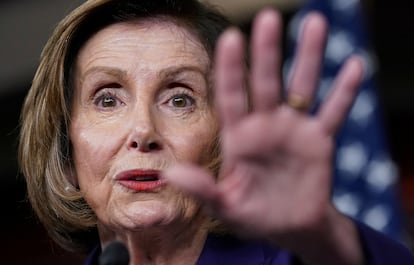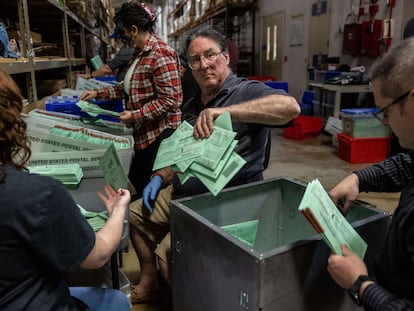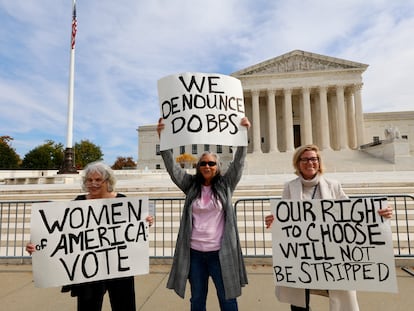Nancy Pelosi steps down as House Democratic leader after Republicans gain majority in lower chamber
The politician was the first woman to be House Speaker and is considered by many to be one of the most powerful people to hold the position


For the past two decades, Democrat Nancy Pelosi, 82, has been a constant presence in the US House of Representatives. She was the first woman to be House Speaker, and has held the position as both a majority and minority leader. Considered by many to be the most powerful Speaker in a century, Pelosi has risen and fallen with the ups and downs of the Democratic Party, which lost its House majority in 2010, and regained it again in 2018. On Thursday, Pelosi announced that she is standing down as leader of the House Democrats, but will continue to represent her California district in the lower chamber of Congress. “The hour has come for a new generation to lead the Democratic caucus,” she said. “When I came to the Congress in 1987 there were 12 Democratic women. Now there are over 90 – and we want more.”
With the Republicans regaining control of the House, Pelosi’s future was hanging in the balance – and not just for political reasons. The recent violent attack on her husband, Paul Pelosi, who was sent to hospital with a fractured skull, may have weighed more heavily on her decision to step down than the fate of the Democratic Party at the midterms, as she herself told CNN ahead of the elections. While some believe that Paul Pelosi’s slow recovery would push her to leave politics, others argued that she was unlikely to let the violent actions of a far-right conspiracy theorist, who planned to break her kneecaps, push her out of the game.
Pelosi, at 82 years of age, has had a long career in politics, one not without missteps. Left-wing critics of Pelosi point out that she resisted beginning the two impeachment proceedings against former president Donald Trump. She feared the process would destroy any possibility of bipartisanship and exacerbate the divisions of an already polarized country.
Her time as House Speaker has not been an easy one. In her first term (2007-2011), the US was in the throes of the global financial crisis. And in the second, which began in 2019, there were two impeachments, the January 6 assault on the US Capitol and the special committee to investigate the attack. According to the book Unchecked: The Untold Story Behind Congress’s Botched Impeachments of Donald Trump, authors Rachael Bade and Karoun Demirjian argue that Pelosi did not act swiftly enough against Trump, not because she thought the case against him wasn’t strong enough, but because she feared the process would be “a political boomerang that once launched could not be controlled.” “She feared that by going after Trump, she would jeopardize her own hard-won majority – and could even hand Trump a second term,” they explain in Politico.
For Pelosi, the third-ranking authority in the United States, it wasn’t enough that Trump had obstructed justice at least 10 times, as outlined in special prosecutor Robert Mueller’s extensive 2019 report. Nor was party pressure enough to sway her. Even for Pelosi’s supporters, her hesitation to impeach Trump over Russia’s interference in the 2020 presidential election is little understood.
Pelosi has often shown that she will choose to follow her judgment over the guidance of the party. Last summer, for example, the House speaker traveled to Taiwan despite warnings from the White House. Her visit to the island, which sparked a diplomatic crisis with China, was seen as a careless act by someone nearing retirement. But her willfulness is also what many people admire about Pelosi. She has been able to secure bipartisan support for key legislation, and is considered one of the most skillful negotiators of the Democratic Party. In her first term as House Speaker, she helped pass the minimum wage rise, prevented the Wall Street meltdown, expanded the health insurance program known as Obamacare and overhauled financial services legislation. In her second term, she forged consensus for Biden’s infrastructure bill and aid packages to soften the impact of the Covid-19 crisis. And thanks to her, she may push through a bipartisan agreement on gun control, albeit a weak one.
Pelosi is a staunch Catholic, yet is also a defender of abortion rights. She was once a Californian housewife, but quickly became a formidable political force as a powerful fundraiser and opponent to the Iraq War. This strength of character has its downside, according to her critics, who believe her reluctance to impeach Trump hurt Congress’ ability to reign in the Republican. As a result, the health and even viability of US democracy has been put to the test. No one was counting on the frightening attack on the US Capitol by pro-Trump supporters. It was an attack that Pelosi lived through in first person, as seen in the video released mid-October, where Pelosi is seen trying to ensure that the violent mob did not derail the process to certify the 2020 election results.
Pelosi has played many roles in the Democratic Party: head of the national committee, plumber, baroness and a machine for getting donations in a country, where the candidate with the most economic support usually wins. When she took back the gavel, in 2018, she did so with a vague promise to leave office at the end of 2022. Four years later, no name has yet emerged of a possible successor. “She has shown more organizational ability and muscle, with really narrow margins, than I would have thought impossible,” Republican Newt Gingrich, her frequent antagonist, said of her last year. “She has been arguably the most powerful [House] speaker in history.”
Tu suscripción se está usando en otro dispositivo
¿Quieres añadir otro usuario a tu suscripción?
Si continúas leyendo en este dispositivo, no se podrá leer en el otro.
FlechaTu suscripción se está usando en otro dispositivo y solo puedes acceder a EL PAÍS desde un dispositivo a la vez.
Si quieres compartir tu cuenta, cambia tu suscripción a la modalidad Premium, así podrás añadir otro usuario. Cada uno accederá con su propia cuenta de email, lo que os permitirá personalizar vuestra experiencia en EL PAÍS.
¿Tienes una suscripción de empresa? Accede aquí para contratar más cuentas.
En el caso de no saber quién está usando tu cuenta, te recomendamos cambiar tu contraseña aquí.
Si decides continuar compartiendo tu cuenta, este mensaje se mostrará en tu dispositivo y en el de la otra persona que está usando tu cuenta de forma indefinida, afectando a tu experiencia de lectura. Puedes consultar aquí los términos y condiciones de la suscripción digital.
More information
Archived In
Últimas noticias
Most viewed
- Oona Chaplin: ‘I told James Cameron that I was living in a treehouse and starting a permaculture project with a friend’
- Reinhard Genzel, Nobel laureate in physics: ‘One-minute videos will never give you the truth’
- Sinaloa Cartel war is taking its toll on Los Chapitos
- Why the price of coffee has skyrocketed: from Brazilian plantations to specialty coffee houses
- Silver prices are going crazy: This is what’s fueling the rally










































